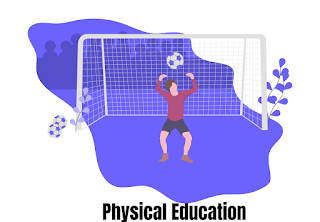The Meaning of Physical Education
Physical education, usually known as PE, is a subject that focuses on developing physical fitness and sporting skills.
It is part of the normal curriculum in schools. It also includes running, jumping, throwing, and other physical activities that help students improve their power, and endurance.
A quick summary of the following concepts might be included in an introduction to physical education:
- What the topic includes,
- Physical health and regular exercise have several advantages.
- Some activities that kids may take part in during a PE class.
Definitions of Physical Education
Charles A Bucher
“Physical Education is an integral part of the total education process and as its aim, the development of physically, mentally, emotionally, and socially fit citizens through the medium of physical activities, which have been selected with a view to realizing these outcomes.”
Charles A Bucher
J. F. Williams
“Physical education is the sum total of well-chosen physical activities of human beings directed towards an objective goal.” – J. F. Williams
J. B. Nash
“Physical education is that part of the whole education that deals with the movement of the large muscles.” – J. B. Nash
Introduction Foundation of Physical Education
Physical education is an essential component of a well-rounded education. It is a course that focuses on bodily growth and provides students with the skills and information they need to live a healthy lifestyle.
Students learn important life skills such as teamwork and goal-setting via physical education. Also, to these advantages, regular physical activity has increased performance, reduce stress, and boosted mental and emotional health. All these aspects combine to make physical education an essential foundation for a healthy and prosperous life.

Physical education programs remove or reduce the following functions: Disease
- Poverty / Frustration
- Anxiety / Depression
- Loneliness
- Desperation
- Hardship
- Disappointment
Physical education programs develop and promote the following human attributes.
- Obedience
- Emotional safety
- UnderstandingsAccomplishment
- Achievement
- Love gives in exchange for services and respect
- Allowing potential to be an exercise
- Respect for the dignity and worth of the human being
- Create equality attributes.
- Patience
- Sincerity
It is an expanding and advanced field all over the world. This is also a health development and physical fitness program, as well as a strong study discipline.
According to the report and facts provided above, physical education programs help in the general growth and development of humans.
Profession in the Field of Physical Education
The meaning of a profession is a learned field that needs training in a specific field of study. The characteristics of a profession are as follows:
- A complex and structured body of knowledge.
- Individuals with excellent skills and knowledge gained through a formal schooling system.
- Mechanisms and chances for professional growth and development within the area to guarantee to keep to recognized competencies and practices.
- Providing a socially recognized and recognized important service. A code of ethics governs governance to safeguard people serviced.
- Professionals in Physical Education (Physical Educators, Exercise, and Sports Scientists) must have a Bachelor’s degree or above.
- They must have extensive education and training.
- They must share research findings and ideas from their professions while serving the public.
History of Physical Education
P.E. started in ancient Greece around 386 B.C. Plato invented and patented physical education, which he taught at his Akademia school. He saw the value of teaching youngsters about physical health, and classes began at the age of seven.
Plato was a great wrestler who knew that combining study and physical exercise helped one achieve perfection.
Physical education helps kids prepare for life as warriors or sportsmen. Wrestling, boxing, and horse racing were popular sports. Physical education programs help the advancement of Greek society, and news of them spread throughout the world.
Physical Education for American Soldiers
Physical education did not begin in the United States until the mid-nineteenth century. P.E., like Athens’s education, prepared and educated warriors for the war. Following the American Civil Battle, regulations were created requiring physical education programs in public schools in order to prepare future generations for war.
Nonetheless, schools used these programs to encourage students to take health seriously and to pay greater attention to physical health and development. During World War I, one-third of military recruits were physically unsuitable for battle. Following that, the government enacted regulations to improve the quality of these courses.
Dedicated to America’s Children
By World War II, physical education was widely used to prepare men and women for battle and arduous work. President Franklin D. Roosevelt created the National School Lunch Program to improve children’s health after the compulsory draft rejected some males due to poor nutrition.
Objectives of Physical Education
- Promote physical fitness
- Develop motor skills and coordination
- Improve overall health and well-being
- Develop social skills, teamwork, and sportsmanship
- Provide an opportunity to learn about and engage in various physical activities
- Promote healthy habits and behaviors
- Help students develop the knowledge, skills, and confidence they need to lead active, healthy lives.
Important Benefits of Physical Education
Physical development: Participating in physical education programs sites the individual and improves skills. And makes him healthier by enhancing the efficiency of his organs and systems.
Kinetic Development: The development of physical awareness with involvement in physical education activities enables the kid to waste less energy and move more efficiently.
Physical development: Participation in physical education activities, improvement of observed behavior, expansion of knowledge, personality development, and giving up bad habits.
The formation of a cooperative attitude and beneficial change through the development of various human qualities are all examples of mental development.
Individual understanding, collective understanding, and establishing oneself as a member of society are social development goals.
Physical education programs promote the development of the best social traits in children and adolescents.
Quiz
[quiz-cat id=”3803″]
Was this helpful?
0 / 0